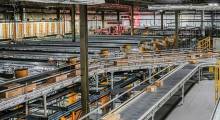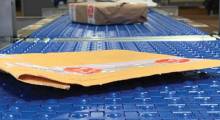Neiman Marcus, Pittston, Pa.
Size: 200,000 square feet
Products: Luxury retail
Throughput: 7.6 million units per year of newly received merchandise
Employees: 125 expanding to 150 during peak seasons.
Shifts per day/days per week: 1 shift per day, 5 days per week; nights and Saturday as needed.
A true multi-use facility, Neiman Marcus’ Pennsylvania DC relies on a superhighway overhead conveyor system and outbound sliding shoe sorter to crossdock merchandise between receiving and shipping. A garment-on-hanger processing area, a high-bay narrow aisle storage rack area and state-of-the-art workstations round out the facility’s operations.
Receiving: The first stop for product arriving on the East Coast is a freight consolidator in Edison, N.J., who forwards some of the merchandise to a primary DC in Longview, Texas. The remainder of the receipt is forwarded to Pittston the next day.
When a truck or container arrives at the receiving dock (1), associates launch the receiving process by scanning a bar code on a shipping carton. Cartons have been packed according to a designated store. The scan tells the associate whether the item is a flat or hanging item and whether it must be audited. Flat product that doesn’t need further processing is crossdocked on the conveyor superhighway (2) directly from receiving to shipping (3). Flat product that requires auditing or value-added processing is conveyed to a flat processing area (4).
Hanging garments that are already on the hanger of choice from the vendor may also be audited on the receiving dock and crossdocked directly to shipping. Otherwise, those garments are conveyed (5) to the garment-on-hanger (GOH) processing area (6).
Crossdocking: Flat product that is ready to be shipped is transported by a powered spiral belt conveyor (7) up and onto the outbound superhighway conveyor system (2). The multiple conveyor lines from receiving and the flat processing area converge into a high-speed merge (8), which releases and feeds the shipping conveyor (9). Cartons are scanned in a scan tunnel (10) and then enter the shipping sorter (11) diverted to the correct outbound trailer at shipping (3) for that order. Powered, flexible conveyor delivers the cartons into each trailer.
Value-added processing: Product that can’t be crossdocked goes to a processing area. There are separate processing areas for flat merchandise (4) and garments on hangers (6).
- Flat processing: In the flat processing area (4), cartons are opened and the items are audited by scanning a bar code. If required, items are also ticketed and then placed in a shipping carton.
- High-value processing area: Since both Neiman Marcus and Bergdorf Goodman are known for luxury goods, the facility features a special secure area (12) to process high-value goods. This area was integrated directly into the facility conveyor system (2) to prevent theft.
- Garment-on-hanger (GOH): In the GOH processing area (6), items may be ticketed and placed on store-ready hangers. Once the garments are on hangers, they are placed on trolleys for transportation to the store. The area uses a gravity slickrail system in conjunction with powered overhead rails (13) to convey trolleys of hanging merchandise to an automated outbound trolley sorter (14) on the shipping dock (3).
Storage: When auditing and value-added services are complete, product designated for Neiman Marcus is conveyed directly to shipping (3). Product designated for Bergdorf Goodman’s store in Manhattan may be conveyed directly to shipping. Or, it may be sent to a very narrow aisle (VNA) pallet and shelving overstock storage area (15).
In the overstock area, associates on narrow aisle pallet trucks and orderpickers are directed by the WMS to store and retrieve merchandise.
Picking and packing: The Bergdorf Goodman store receives replenishment orders on a daily basis. The facility also receives online orders and customer orders from Northeastern stores.
To fill the Bergdorf Goodman online orders, the system prints a pick sheet that organizes picks by zone and other order characteristics. For instance, some picks can be reached by an associate on foot while others require an orderpicker lift truck. Associates pick items and scan them into a tote. The totes are then conveyed to wrap and packing stations (16) where the items are prepared for shipment.
Once orders are ready to ship, they can be conveyed to the outbound crossdock conveyor (2), where they will be merged (8), scanned (10) and then sorted (11) to a parcel shipment truck. Or, they can be palletized by floor for shipment to the Bergdorf Goodman store. Once they arrive at the store, pallets are delivered to the right floor for the items on the pallet.
System suppliers
Materials handling design: Johnson Stephens Consulting
System integration: Conveying Solutions
Economic incentives advisor: Rubin Advisors
Conveyor and sortation: Dematic
Pallet rack: Interlake Mecalux
Mezzanine: Steele Solutions
Warehouse control system: Pyramid Controls
Warehouse management system: Manhattan Associates
Bar code scanning: Sick
Workstations: Dehnco
Lift trucks: Crown








